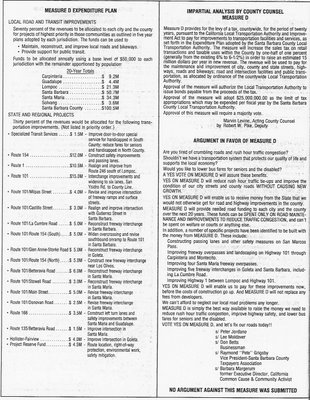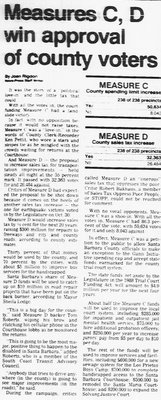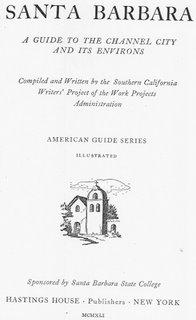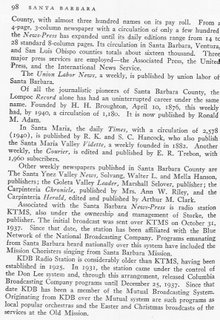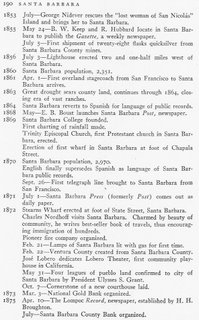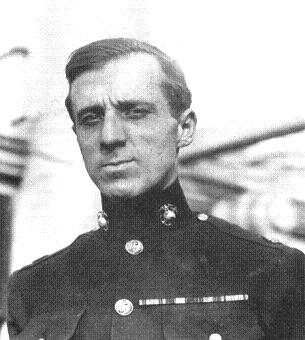The
Santa Barbara News-Press gave the date of its foundation as 1863 until 1952, when it changed its birthdate to 1855. The occasion of this change was a `Golden Jubilee' for Thomas M. Storke, the prominent publisher of the
News-Press. A special Golden Jubilee insert was produced on March 30, 1952, the official date of the Jubilee; the opening of the
News-Press offices on De La Guerra Plaza in Santa Barbara was also celebrated by the Jubilee.
The top of the paper
before the change, on March 29, 1952 is below. Note on the far left where it says `Eighty-ninth Year, No. 152' (you can click on the image to enlarge it). Also, just below I've put an enlargement of these words.


This year of age and enumeration, assuming 365 issues a year (well, 1952 was a leap year, so 366), leads to a birthdate of Oct. 20, 1863.
The top of the paper
after the change, on March 30, 1952 is below. Note on the far left where it says `Ninety-Seventh Year, No. 312' (you can click on the image to enlarge it).


This year of age and enumeration leads to a birth date of May 14, 1855. That is slightly at odds with the date of the first edition of the
Santa Barbara Gazette, the newspaper that first published on May 24, 1855, and whose start the
News-Press claimed `by right of inheritance' according to an article published in the special Jubilee insert of the March 30, 1952
News-Press, and reproduced below.
In one day, the
News-Press aged over 8 and 1/2 years... its birthdate went from 1863 to 1855.
Below is the article from the March 20, 1952 edition of the
News-Press that provides a history of newspaper publishing in Santa Barbara.
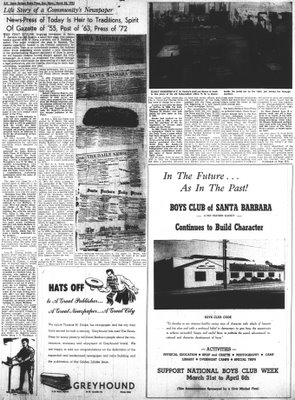

This article is definitely not readable at the resolution allowed by Blogger. It is reproduced below. However, there is a known inaccuracy in the statement, pretty near the end:
Without interruption, from today's
News-Press back through the Daily
Press, the Weekly Press and the Post,
it is now 89 years old.
The
Daily Press did not publish continuously. According to
California Editor by Thomas M. Storke, p. 94, the
Daily Press stopped publishing during the summer of 1880, approximately from July 1, 1880 until Sep. 1, 1880.
THE FIRST ENGLISH language newspaper
in Santa Barbara was the Gazette, a small
four page, five column weekly started
by B. W. Keep, a printer, and R. Hubbard,
a writer. This paper contained one page
in Spanish. The Gazette apparently
basked in the friendly community for
several years. Then in an unfortunate mo-
ment, the luckless editor wrote something
which carried a note discordant to
the predominating religious sentiment of
those in power for the Spanish element
turned sharply against the little
newspaper. As a result, an enactment was
rushed through the legislature which made
the mere posting of a legal notice a legal
publication, and the Gazette, receiving no
more legal advertising, languished and died.
E. B. Boust and a man named Ferguson took
over where the Gazette left off and published
their first edition of the new Post, in 1863.
Boust was an ardent Secessionist, but a pru-
dent man. The final tragic chapter of the
war between the states being then in
progress, he was content to devote the
columns of his little weekly to matters other
than the great war.
He was joined shortly by J. A. Johnson, a re-
tired clergyman who organized the First
Congretational Church here. After a time,
Johnson became the sole owner of the Post
by buying the interests of his associates,
and on June 24, 1869, he changed the name
of the little weekly newspaper to
the Press.
On Sep. 9, 1872, Johnson issued
the first number of the Santa Barbara
Daily Press, and from 1872 to 1876
he published both the weekly and the
daily Press, through their columns
strongly advocating numerous
projects he believed to be for
the advancement of Santa Barbara.He even traveled over the East, speaking and
writing about the opportunities for success-
ful enterprise which abounded in California.
Two years after Johnson launched
the Santa Barbara Daily Press, Al
Pettygrove and company started the
Daily News. The first issue appeared
May 3, 1874. Associated with Petty-
grove was E. M. Hott, a capable news-
paperman. Two years later, on May 16,
1876, the Santa Barbara Daily Press
and the Daily News united in a
consolidation, continuing publication
under the name of the Daily Press.
The coast was swept by a financial panic in
1875 and in the following year Johnson lost
the Press, and Col. W. W. Hollister, one of
the foremost men of the community, took
over the paper.
Harrison Gray Otis (General Otis
of later years), a brilliant young
newspaperman employed on the Ohio
Statesman, was induced by Col.
Hollister to come West and assume
editorial charge of the Press. On
March 11, 1876, Otis took the position.
He, with his talented wife, Eliza A.
Otis, who was a constant contributor,
where making a strong newspaper of
the Press when another financial panic
struck California, and they left Santa
Barbara to establish a home in Los An-
geles. Their Otis took charge of the
Times, which has become a worthy
monument to his memory.R. D. Bogart, associated with Otis on the
Press, went to San Francisco about the same
time and established the Wasp, a periodical
that became widely celebated.
John P. Stearns, builder of Stearns wharf
and one of Santa Barbara's real captains
of industry, acquired the Press in 1888.
Theodore M. Glancey, a young man of
marked literary attainments, took editorial
charge.
On Sept. 23 of that year, Glancey was
shot and mortally wounded by
Clarence Gray, an attorney, who
aspired to the post of district
attorney and was made the subject of
editorial criticism by Glancy. Gray
was spirited to a jail out of town --
some say Los Angeles, others
Ventura -- to avoid lynching. He was
tried in San Jose because of the high
feeling here and, after two jury disa-
greements, went free. He died misera-
bly some years later in San Francisco,
an outcast, never returning to Santa
Barbara.C. F. McGlashen, who joined the Press
editorial staff in 1880, became the next
owner of the paper, with George P. Tebbets
as business manager. Later, they sold to
W. G. Kinsell. From him the paper passed
to Walter Nixon, and in 1892 George Knepper,
and Eastern educator, and John T. Johnston
became owners. After a brief period the
Press passed to a syndicate headed by the
late R. B. Canfield, C. A. Edwards and others,
the majority stockholder being I. G. Waterman,
a young millionaire. Clio L. Lloyd was put in
as business manager, and Frank Selover became
editor.
In 1898 Waterman sold the Press to
R. B. Fithian, who moved the Press plant to
the Fithian building. Frank Hunt, who had
been with the Press since 1872, starting as
a printer's devil, was made manager.
Robert Cameron Rogers, one of
Santa Barbara's most gifted authors
of both prose and verse, next
acquired the Press from the Fithian
interests, and its columns reflected
his scholarly guidance. Mr. Rogers
died in 1912, and Reginald G. Fernald,
Mr. Roger's brother-in-law, became
publisher of the Press.
On Feb. 1, 1870, the Times was started by
E. Boust, the same man who seven years be-
fore had started the Post, which a year later
became the Press. The Times had one defi-
nite policy, which was to oppose anything
advocated or favored by the Press, and conse-
quently it strongly opposed extending any
encouragement to the Atlantic & Pacific Rail-
road Co. Judge Jarrett T. Richards, a most
able jurist, succeeded to the ownership of
the Times, but even his ability and promi-
nence in the community was not sufficient to
carry the little paper through the throes of
a severe financial panic, and it ceased
publication in 1875.
In 1872 E. N. Wood started the Index, which
was noted for the almost classic style in
which many of its articles were written,
while the exquisite beauty of the verse con-
tributed by Mrs. Wood, the editor's wife,
added to its fame. Mr. Wood died on Oct. 14,
1874, the Index passing to the ownership of
Mr. and Mrs. William F. Russell. The
Russells were from Minnesota, where Russell
had been prominent in politics, and was a
leading member of of the Minnesota
constitutional convention. He was a Union
veteran, distinguished for his outstanding war
services. The Russells were highly talented,
but as they were impractical, both in business
affairs and in their inability to restrain
free expression of opinion which might clash
with accepted religious and moral ideas, the
Index shortly ceased to exist, despite the
unusual literary atmosphere which its pages
reflected.
On May 25, 1875, the Daily Republican was
launched by A. S. Winchester, while two years
later, in 1876, the Daily Advertiser was
started by Pettygrove & Stone. The Advertiser
succumbed on Nov. 29 of the same year, while
the Republican, which was strongly pro-Repub-
lican, continued for a time longer, only to
disappear in the financial quicksands which
had trapped so many other ambitious
newspaper ventures here since the little
Gazette blazed the way.
In 1878 the Democrat was started by
B. W. Keep,E. Boust, and F. A. Moore and this
proved a more enduring venture than many of
the others. It continued through eight years
as the Democrat, and wielded much influence
at times. Then, in 1886, Keep and Boust sold
their interests in the paper to Moore, who
changed the name of his paper to the
Independent.
The Independent passed from Moore to
George P. Tebbetts, and from Tebbetts to
William LaVies. Under LaVies' ownership,
Clio L. Lloyd and Charles Donahoe were in
charge for a time.
A year or two after the death
of LaVies in 1898, the Independent
passed by purchase to Thomas M.
Storke, who established his first
issue on Jan. 2, 1901.
Storke had worked on the Press, and
in 1899, a year before his purchase
of the Independent, he became night
editor on the Press.
In 1895, Frank Sands started a news-
paper which he called the Daily
News, a name which had been dropped
in the merger of the Press and Daily
News, several years before. Mr.
Storke purchased the Daily News from
Mr. Sands--13 years after the pur-
chase of the Independent and the two
papers were consolidated under the
name of Santa Barbara Daily News.For 35 years, from its start in 1878 to 1913,
the Independent had been a powerful influence
in local and county affairs, and the consoli-
dation of the Independent and the News proved
the beginning of a new epoch in local news-
paper history.
The consolidation left Santa Barbara with but
two papers, the News and the Press. In 1932
these consolidated. The merger brought Santa
Barbara a strong daily newspaper, with morning
and evening and Sunday issues. Until
April 21, 1937, the News and the Press were
kept as separate issues, and together
published a Sunday edition known as the
Sunday Editions of the News and the Press.
Another newspaper which started forth in a
fine way was the Santa Barbaran. It was
started by C. C. Davis, who came to Santa Bar-
bara from Leadville, Colo. The community
gripped his imagination, as it had that of
the men who had come before him. His little
paper, printed on book paper, appeared in
1897. It was a gem typographically, and in
a literary sense as well, but those same
financial quicksands which had drawn down so
many others ended the career of this little
journal also.
The Santa Barbara News-Press, as published
today, traces its ancestral lineage back to
the first of local newspaper history in 1855.
Without interruption, from today's News-Press
back through the Daily Press, the Weekly Press
and the Post, it is now 89 years old. Through
the right of inheritance, from the days of the
Daily Press it is the oldest daily newspaper
still being published in Southern California.
With the exception of a few months between
the days of the Post and the Gazette when
Santa Barbara had no newspaper there is an
unbroken chain of interwoven ancestry
between Santa Barbara's first newspaper, the
Gazette, established in 1855, and The
News-Press of 1952.
The News-Press of today, housed in its own
building, with the lastest equipment through-
out, and served by press services that cover
the globe, would not be recognized in any
characteristic by its great-grandfather news-
papers, the Post of 89 years ago, or the
Gazette of 97 years.
In those distant days if a printer
could run off a hundred or so copies
of his little four-page sheet an hour he
was doing something, while today the
80-page highspeed multiple color Goss
press can print and fold 666 copies
of the News-Press a minute, or 40,000
copies an hour.As news pours in from every corner of the earth,
teletypes, working automatically, turn out
telegraph news in copy form ready for the
battery of lino-type machines.
In every department of the plant, from stereo-
typing and printing to engraving, modern
mechanism, with precision more than human,
suggests the long road that the newspaper
profession has traveled since those early-day
editors and printers wrestled with their
problems.
But there is a continuity running
through all this Santa Barbara
newspaper history. It started at
a time when the Gazette editor could
look back only three years to Indian
raids on the county's ranches, and
plead for the continuance of Fort
Tejon to protect the counties of
Santa Barbara, San Luis Obispo, Los
Angeles, San Diego, and San
Bernardino.All the newspapers that followed the Gazette--
the Post, Press, Advertiser, Index, Republi-
can, Democrat, Independent, Barbaran--
directly and indirectly form a living link
contributing something of worth to the
individuality that today finds expression
in Santa Barbara's News-Press.

